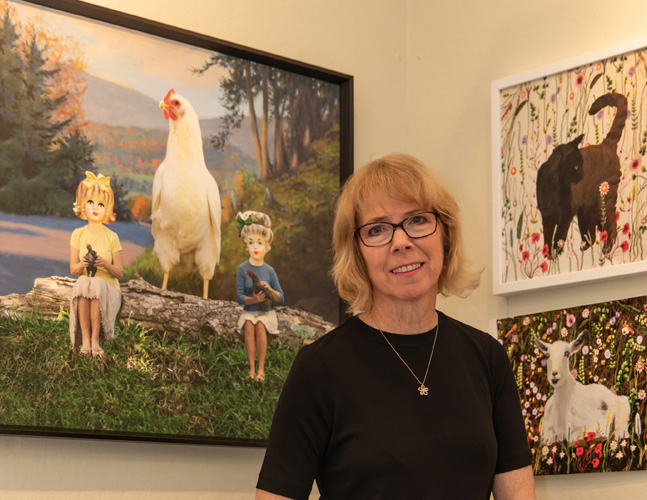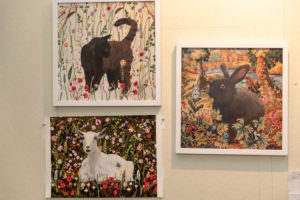
Since we last saw her in Vero, winter resident Jill Kerwick has been busy exhibiting her photography-based art in her home state of New Jersey. She had three solo shows there since last spring: April saw the opening of “Jill Kerwick: Almost Definitely” at the Center for Contemporary Art in Bedminster; in June her “Art is Serious Play” opened at Gallery 491 in Montclair; and in October “Jill Kerwick: A Retrospective” was installed at Beauregard Fine Art Gallery in Rumson. The latter featured selected works from the past 18 years of the artist’s career.
Now Vero Beach art lovers can see what all the fuss is about at Kerwick’s first solo show in our city.

Jill Kerwick. Photos: Denise Ritchie
A selection of paintings and digital photo prints, “Leaving Home and Other Stories” will be presented through February at Vero’s Center for Spiritual Care. Kerwick will meet her public at a reception for the exhibition from 5 p.m. to 7 p.m. on Feb. 1.
A fine line differentiates Kerwick’s paintings from her prints, and that line – deftly drawn by the artist herself – is what makes her work in both mediums so intriguing.
The title of one of the photo prints, “Active Listening” of 2015, relates to a skill the Center for Spiritual Care prides itself on. It shows two blond women, seated in a country landscape, enjoying a heart-to-heart over mugs of coffee. It is a perfect day. Puffy clouds floating over distant, wooded hills form a peaceful backdrop for the two friends, whose intent expressions preclude the baby Dumbo-sized rabbit seated directly behind them.
A closer look at the women’s porcelain faces reveal that they belong to vintage lady head vases found in thrift shops; Kerwick has a half-dozen or so of them in her private collection.
Dressed in pastel sweaters and wearing the same ecru skirt, the bodies of the women belong to Kerwick herself, Photoshopped into the scene. The only “real” part of the picture is the artist’s pet rabbit, Palmer, who was photographed on a rectangle of sod in front of a pastoral oil painting.
Kerwick refers to her photographic confabulations as collages, because in past years she created her unsettling pictures the old-fashioned way – carefully cutting imagery from magazines and books and adhering them onto other similarly obtained backdrops.
She eventually graduated to using imagery she photographed herself, clad in costumes appropriate to the various situations her lady heads would find themselves in. In her earlier works, those backgrounds included the sun and sand of Costa Rica, a favored winter destination.
The use of paintings by her father, the late Thomas Kerwick, as a backdrop for her mini stage sets began in 2012. Kerwick has since used paintings that she created as photo backdrops, as well as paintings she purchased from thrift and antique shops.
“Sea Women” of 2018 makes use of a marine painting Kerwick created in 2010. The original oil on panel painting features a flotilla of Spanish galleons and smaller long boats positioned near the sea’s horizon; in the foreground’s shoreline surf a woman in a red one-piece rides a boogie board. In the current show’s photo print, the playful woman has been replaced by five lady-head women bobbing serenely in the shallows; the ominous fleet looming behind them.
Similar to a movie still, Kerwick’s photo collages set up the atmosphere for a story that effectively tells itself. The poignant print “Leaving Home” of 2018 shows a blond lady-head figure dressed up in pearl necklace and matching earrings, seated outdoors on a convenient rock, doubtless next to a dusty country road. She holds a valise in one hand and straw hat in the other; a pair of sensible walking shoes on her feet. The young woman’s companion, a rooster the size of a Bernese mountain dog, is presumably from the same rural homestead pictured in the oil painting behind them.
Anyone who has spent time on the Internet has seen thousands of photographically altered pictures designed to elicit a giggle before the inevitable scroll to the next easy laugh. Like “Leaving Home,” Kerwick’s photographic works have their patently absurd elements, but there is something about them that is decidedly more Magritte than ‘meme,’ more “The Birds” than “Birdbox.”
Perhaps it is the artist’s sincerity mixed with her winking sense of fun that makes her pictures art worthy. A 1978 B.F.A. graduate from Moore College of Art in Philadelphia, Kerwick has been around long enough to remember the lady-head vase craze of the 1960s.
By the time she began to collect the heads they were already considered passé, but for Kerwick the kitschy objects serve in much the same capacity as Proust’s homely madeleine. They recall a time when painting still reigned as queen of the arts; the term ‘artist’ was applied to painters and sculptors and computers were glorified information storage units.
Perhaps, in combining the old-fashioned media of painting with the electronic technology of Photoshop, Kerwick hopes to keep those touchstones of a lost time in art and American culture relevant into the foreseeable future.
Kerwick also confutes painting and digital photo-making by actually putting brush to paper, as two 2018 works in the current show attest. Both were created by hand-applying oil and acrylic paint atop photographic pigment prints on paper.
The 16-inch square composition titled “The Hogan Tapestry” shows a brown bunny (another Kerwick pet) painted amidst the photographically reproduced foliage of a French tapestry in such a way that part of the photograph (the tapestry’s flowers and leaves) overlaps the painting of the bunny, and the painted bunny overlaps the tapestry’s background.
To create her artwork, Kerwick explains that she first makes a photo print of her “base” (in this case, a tapestry). She then makes a pencil drawing of the subject of the painting (here, Hogan the rabbit). After photo-mechanically enlarging her drawing, she cuts and uses it as a stencil to outline the subject directly onto the base. Kerwick used a rapid, brushy-style to paint Hogan; combining seemingly incompatible art forms – painting and photography – in one work.
Created in the same technique, the field of floral embroidery in “Anthropologie Cat” is a photographic detail of a skirt she purchased from the clothing store, Anthropologie.
“I loved the skirt, but it looked horrible on me,” Kerwick says.
But then she remembered that the late French-American artist Louise Bourgeois “made fabulous art out of her old clothes,” specifically, the faded, threadbare housecoats, dresses and slips that Bourgeois used as elements in her sculptural installations.
For Kerwick, as well as Bourgeois, memory is the stuff of which contemporary art is made.



